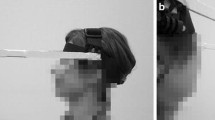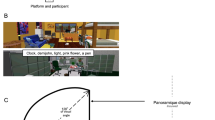Summary
The present study attempts to clarify the relationship between eye and body positioning during an upside-down standing posture on the hands. In this posture the head was observed to be stable and the eyes were anchored to an earth-fixed target. We measured the variations of body sway when subjects displaced their gaze upward or downward from their anchoring position. They did this voluntarily under instruction, and involuntarily by means of base-down or base-up wedge prisms. Results show that the anchoring point chosen by the subjects corresponds to a perceived limit of their body sway. They suggest that vision is also used to convey the desired optimal zone for the center of gravity in cases where fine balance is required.
Similar content being viewed by others
References
Amblard B, Carblanc A (1980) Role of foveal and peripheral visual information in maintenance of postural equilibrium in man. Percept Mot Skills 51: 903–912
André-Deshays C, Berthoz A, Revel M (1988) Eye-head coupling in humans. Exp Brain Res 69: 399–406
Baron JB, Cernacek J, Niederlandova Z, Ushio N (1976) Réflexe optomoteur et activité tonique posturale orthostatique. Pract Otolog (Kyoto) 69, 3: 1246–1249
Berthoz A (1987) Influence of gaze on postural mechanisms. Neuroscience Suppl 22: S575
Berthoz A, Pavard B, Young LR (1975) Perception of linear self-motion induced by peripheral vision (linear vection). Basics characteristics and visual-vestibular interactions. Exp Brain Res 23: 471–489
Berthoz A, Lacour M, Soechting JF, Vidal PP (1979) The role of vision during linear motion. In: Granit R, Pompeiano O (eds) Reflex control of posture and movement. Progress brain research, Vol 50. Elsevier, Amsterdam New York, pp 197–209
Brandt Th, Dichgans J, Koenig E (1973) Differential effect of central versus peripheral vision on egocentric and exocentric motion perception. Exp Brain Res 16: 476–491
Chu WHN (1979) Dynamic response of linearvection. Master thesis. MIT Cambridge, Massachusetts
Clément G, Magnin M (1983) Visual influence on postural control in the cat. Exp Brain Res 55: 49–59
Clément G, Rézette D (1985) Motor behavior underlying the control of an upside-down vertical posture. Exp Brain Res 59: 478–484
Da Cunha HM, Da Silva OA (1986) Disturbances of binocular function in the postural deficiency syndrome. Aggressologie 27: 63–67
De Wit G (1972) Optic versus vestibular and proprioceptive impulses measured by posturometry. Aggressologie 13B: 75–79
Dichgans J, Held R, Young LR, Brandt Th (1972) Moving visual scenes influence the apparent direction of gravity. Science 178: 1217–1219
Dichgans J, Mauritz KH, Allum JHJ, Brandt Th (1976) Postural sway in normal and atactic patients: analysis of the stabilizing and destabilizing effects of vision. Aggressologie 17C: 15–24
Dichgans J, Schmidt CL, Graf W (1973) Visual input improves the speedmeter function of the vestibular nuclei in the goldfish. Exp Brain Res 18: 319–322
Fukuda T (1983) Statokinetic reflexes in equilibrium and movement. University of Tokyo Press, Tokyo
Fuller JH (1980) The dynamic neck-eye reflex in animals. Exp Brain Res 41: 29–35
Gagey PM, Baron JB, Lespargot J, Poli JP (1973) Variations de l'activité tonique posturale et activité des muscles oculocéphalogyres en cathédrostatisme. Aggressologie 14B: 87–95
Gantchev GN, Draganova N, Dunev S (1972) The role of visual information and ocular movements in the maintenance of body equilibrium. Aggressologie 13B: 55–61
Gresty MA (1975) Eye, head, and body movements of the guinea-pig in response to optokinetic stimulation and sinusoidal oscillation in yaw. Pflügers Arch 353: 201–214
Gurfinkel VS, Lipshits MI, Mori S, Popov KE (1976) Postural reactions to the controlled sinusoidal displacement of the supporting platform. Aggressologie 14C: 1–8
Harris CS (1965) Perceptual adaptation to inverted, reversed and displaced vision. Psychol Rev 72: 419–444
Hay JC, Pick HL (1966) Visual and proprioceptive adaptation to optical displacement of the visual stimulus. J Exp Psychol 71: 150–158
Held R, Mikaelian H (1964) Motor-sensory feed-back versus need in adaptation to rearrangement. Percept Mot Skills 18: 685–688
Helmoltz H (1867) Optique physiologique (translated by Javal E, Klein N). Masson, Paris
Lackner JR (1973) The role of posture in adaptation to visual rearrangement. Neuropsychology 11: 33–44
Lee DN, Aronson E (1974) Visual proprioceptive control of standing in human infants. Percept Psychophys 15: 523–532
Lee DN, Lishman JR (1977) Vision, the most efficient source of proprioceptive information for balance control. Aggressologie 18: 83–94
Lestienne F, Soechting JF, Berthoz A (1977) Postural readjustments induced by linear motion of visual scenes. Exp Brain Res 28: 363–384
Mauritz KH, Dichgans J, Hufschmidt A (1977) The angle of vision roll motion determines displacement of subjective vertical. Percept Psychophys 22: 557–562
McLaughin SC, Rifkin KI, Webster RG (1966) Oculomotor adaptation to wedge prisms with no part of the body seen. Percept Psychophys 1: 452–457
Nashner LM, Berthoz A (1978) Visual contribution to rapid motor responses during postural control. Brain Res 150: 403–407
Oblak B, Gregotic M, Gyergyck L (1985) Effects of voluntary eye saccades on body sway. In: Igarashi M, Black O (eds) Vestibular control of posture and locomotor equilibrium. Karger, Basel, pp 99–104
Paulus WM, Straub A, Brandt Th (1984) Visual stabilization of posture: physiological stimulus characteristics and clinical aspects. Brain 107: 1143–1163
Roll JP, Roll R (1986) Kinaesthetic and motor effects of extraocular muscle vibration in man. In: O'Regan JK, Levy-Schoen A (eds) Eye movement. Elsevier, Amsterdam, pp 57–68
Vidal PP, Roucoux A, Berthoz A (1982) Horizontal eye position related activity in neck muscles of alert cat. Exp Brain Res 46: 448–453
White KD, Post RB, Leibowitz HW (1980) Saccadic eye movements and body sway. Science 208: 621–623
Author information
Authors and Affiliations
Rights and permissions
About this article
Cite this article
Clément, G., Pozzo, T. & Berthoz, A. Contribution of eye positioning to control of the upside-down standing posture. Exp Brain Res 73, 569–576 (1988). https://doi.org/10.1007/BF00406615
Received:
Accepted:
Issue Date:
DOI: https://doi.org/10.1007/BF00406615




